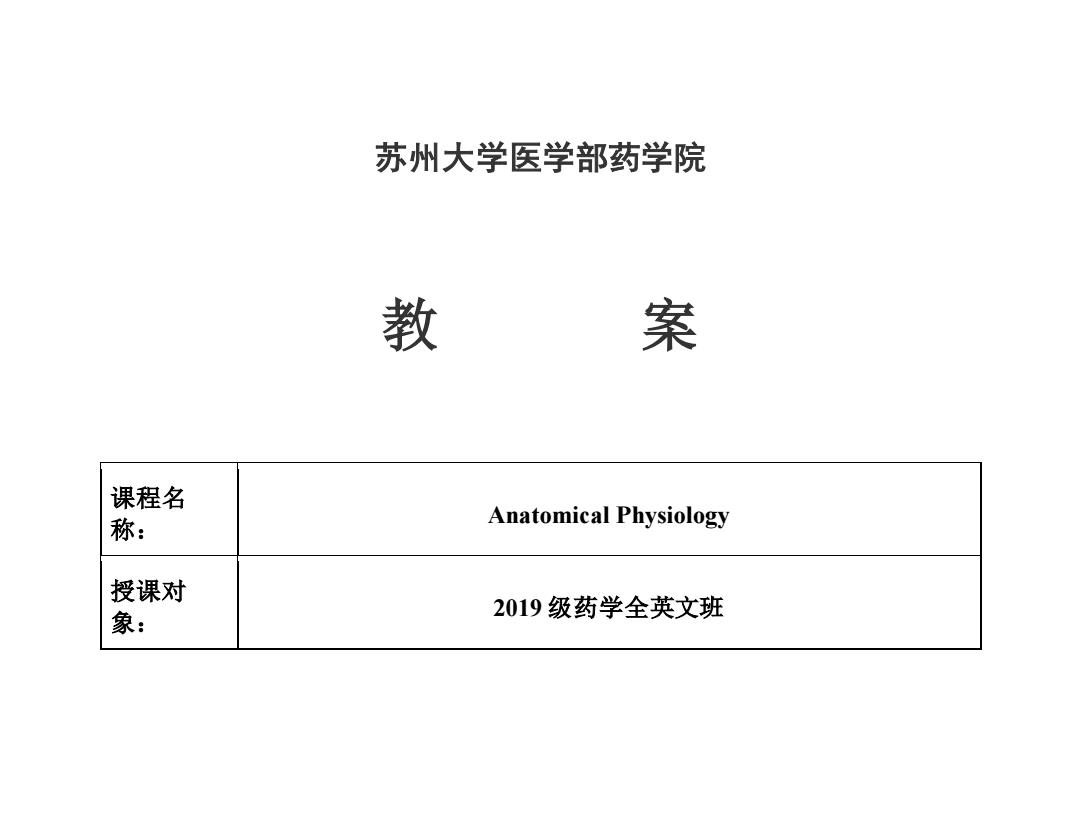
苏州大学医学部药学院 教 案 课程名 称: Anatomical Physiology 授课对 象: 2019级药学全英文班
苏州大学医学部药学院 教 案 课程名 称: Anatomical Physiology 授课对 象: 2019 级药学全英文班
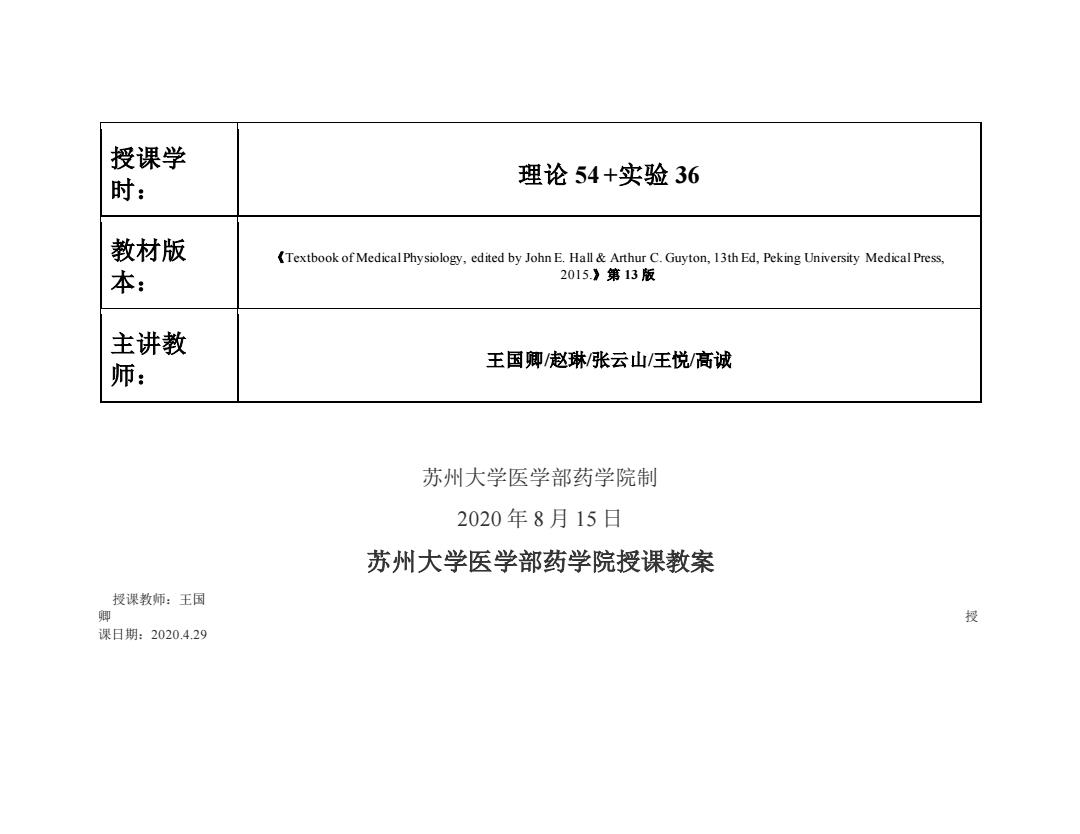
授课学 时: 理论54+实验36 教材版 (Textbook of MedicalPhysiology,edited by John E.Hall Arthur C.Guyton,13th Ed,Peking University Medical Press, 本: 2015.》第13版 主讲教 师: 王国卿/赵琳/张云山/王悦/高诚 苏州大学医学部药学院制 2020年8月15日 苏州大学医学部药学院授课教案 授课教师:王国 卿 授 课日期:2020.4.29
授课学 时: 理论 54 +实验 36 教材版 本: 《Textbook of Medical Physiology, edited by John E. Hall & Arthur C. Guyton, 13th Ed, Peking University Medical Press, 2015.》第 13 版 主讲教 师: 王国卿/赵琳/张云山/王悦/高诚 苏州大学医学部药学院制 2020 年 8 月 15 日 苏州大学医学部药学院授课教案 授课教师:王国 卿 授 课日期:2020.4.29

课程名称 所属学 Anatomical Physiology 科 解剖学、生理学 教材名称 (Textbook of Medical Physiology,edited by John E.Hall Arthur C.Guyton,13th Ed,Peking University 授课年 2019级药学全 Medical Press,20l5.》第13版 级 英文班 授课章节 授课时 1. Basic Physiological Function of Human Body 间 200分钟 1. 教学目标:含知识目标、技能(能力)目标 1. 知识目标: Understanding regulation manner of functional activities.Master concept of internal environmenthomeostasis.Understanding material transportation of cellular membrane.Master bioelectricity production and basic principle of excitory conduction.Master mechanism of muscular contraction. 1. 2.技能(能力)目标:结合实验课程目标 (1)Physiological computer introduction: (2)Preparation of sciatic nerve-gastrocnemius specimen. (3)Single twitch and complete tetanus of skeletal muscle. 2. 授课内容(依据散学大纲)及时间分配 Internalenvironment and homeostasis ofhuman body0.25 hr Regulations of body physiological functions0.50 hr Control system inside body0.25 hr
课程名称 Anatomical Physiology 所属学 科 解剖学、生理学 教材名称 《Textbook of Medical Physiology, edited by John E. Hall & Arthur C. Guyton, 13th Ed, Peking University Medical Press, 2015.》第 13 版 授课年 级 2019 级药学全 英文班 授课章节 1. Basic Physiological Function of Human Body 授课时 间 200 分钟 1. 教学目标:含知识目标、技能(能力)目标 1. 知识目标: Understanding regulation manner of functional activities. Master concept of internal environmenthomeostasis. Understanding material transportation of cellular membrane. Master bioelectricity production and basic principle of excitory conduction. Master mechanism of muscular contraction. 1. 2. 技能(能力)目标:结合实验课程目标 (1)Physiological computer introduction; (2)Preparation of sciatic nerve-gastrocnemius specimen. (3)Single twitch and complete tetanus of skeletal muscle. 2. 授课内容(依据教学大纲)及时间分配 Internal environment and homeostasis of human body0.25 hr Regulations of body physiological functions0.50 hr Control system inside body0.25 hr
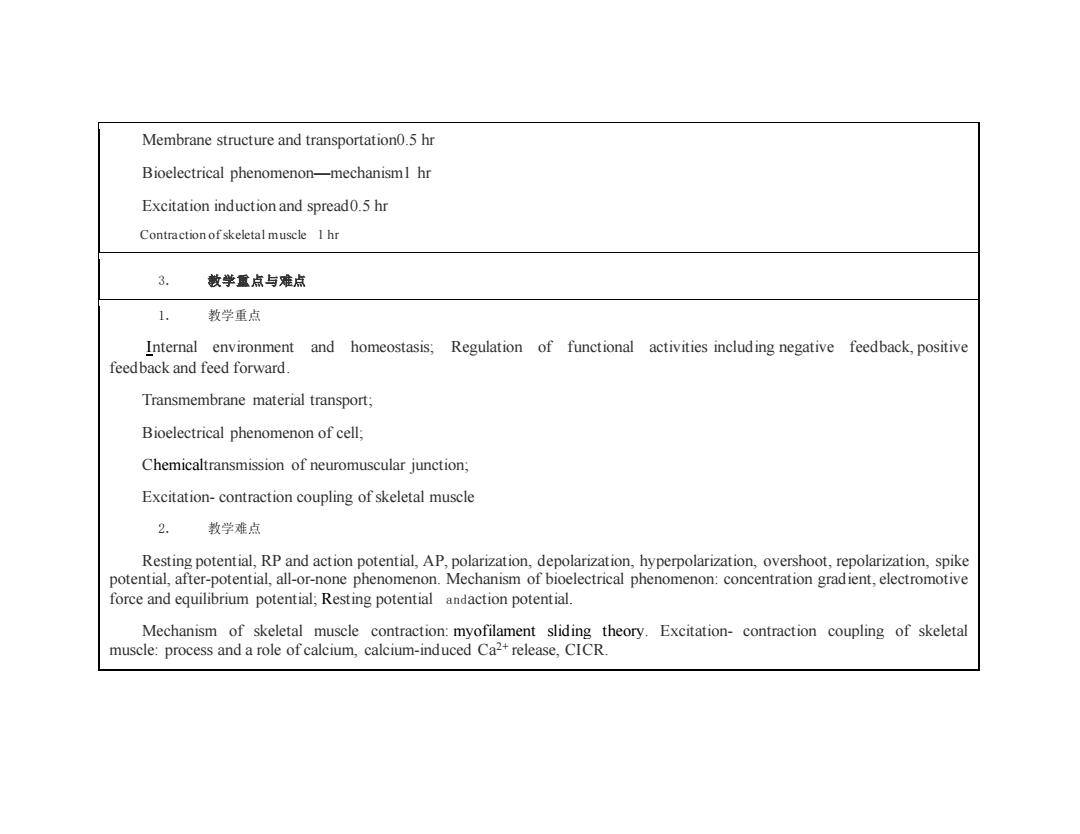
Membrane structure and transportation0.5 hr Bioelectrical phenomenon-mechanisml hr Excitation induction and spread0.5 hr Contraction of skeletal muscle I hr 3. 教学靈点与难点 1. 教学重点 Internal environment and homeostasis; Regulation of functional activities including negative feedback,positive feedback and feed forward. Transmembrane material transport; Bioelectrical phenomenon of cell: Chemicaltransmission of neuromuscular junction; Excitation-contraction coupling of skeletal muscle 2 教学难点 Resting potential,RP and action potential,AP,polarization,depolarization,hyperpolarization,overshoot,repolarization,spike potential,after-potential,all-or-none phenomenon.Mechanism of bioelectrical phenomenon:concentration gradient,electromotive force and equilibrium potential;Resting potential andaction potential. Mechanism of skeletal muscle contraction:myofilament sliding theory.Excitation-contraction coupling of skeletal muscle:process and a role of calcium,calcium-induced Ca2+release,CICR
Membrane structure and transportation0.5 hr Bioelectrical phenomenon—mechanism1 hr Excitation induction and spread0.5 hr Contraction of skeletal muscle 1 hr 3. 教学重点与难点 1. 教学重点 Internal environment and homeostasis; Regulation of functional activities including negative feedback, positive feedback and feed forward. Transmembrane material transport; Bioelectrical phenomenon of cell; Chemicaltransmission of neuromuscular junction; Excitation- contraction coupling of skeletal muscle 2. 教学难点 Resting potential, RP and action potential, AP, polarization, depolarization, hyperpolarization, overshoot, repolarization, spike potential, after-potential, all-or-none phenomenon. Mechanism of bioelectrical phenomenon: concentration gradient, electromotive force and equilibrium potential; Resting potential andaction potential. Mechanism of skeletal muscle contraction: myofilament sliding theory. Excitation- contraction coupling of skeletal muscle: process and a role of calcium, calcium-induced Ca2+ release, CICR
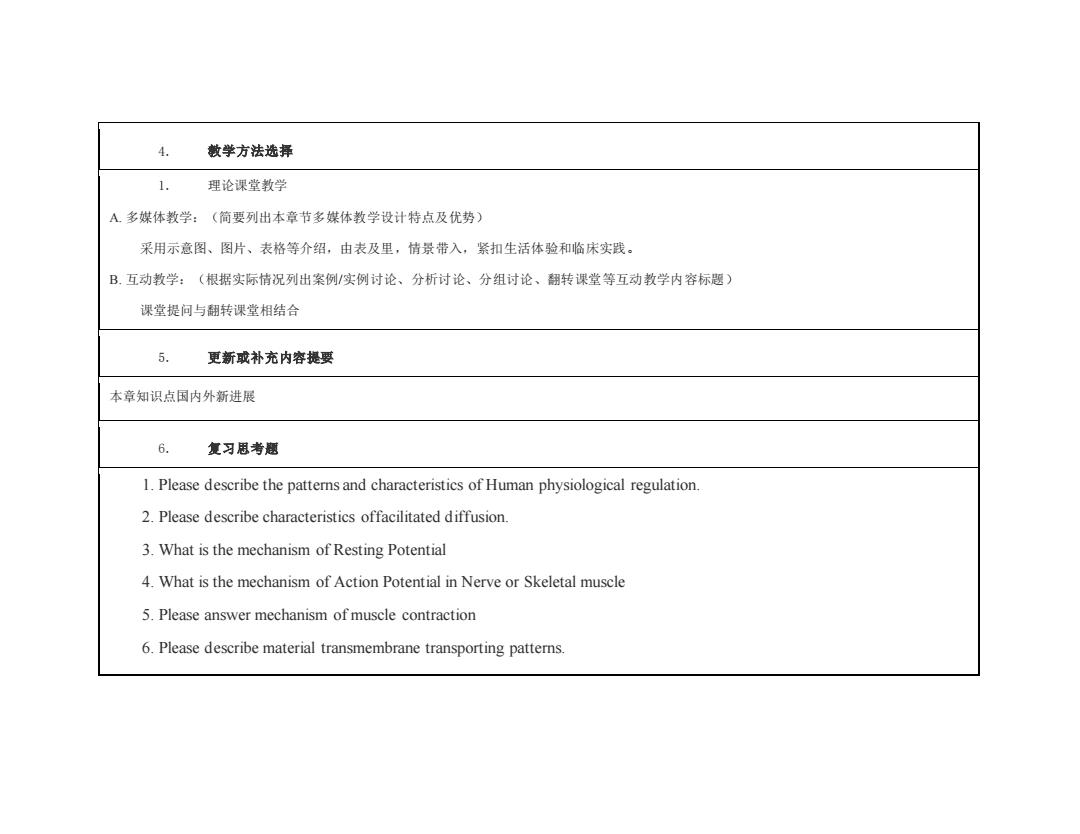
4. 散学方法选择 1. 理论课堂教学 A多媒体教学:(简要列出本章节多媒体教学设计特点及优势) 采用示意图、图片、表格等介绍,由表及里,情景带入,紧扣生活体验和临床实践。 B.互动教学:(根据实际情况列出案例/实例讨论、分析讨论、分组讨论、翻转课堂等互动教学内容标题) 课堂提问与翻转课堂相结合 6 更新或补充内容提要 本章知识点国内外新进展 6. 复习思考题 1.Please describe the patterns and characteristics of Human physiological regulation. 2.Please describe characteristics offacilitated diffusion. 3.What is the mechanism of Resting Potential 4.What is the mechanism of Action Potential in Nerve or Skeletal muscle 5.Please answer mechanism of muscle contraction 6.Please describe material transmembrane transporting patterns
4. 教学方法选择 1. 理论课堂教学 A. 多媒体教学:(简要列出本章节多媒体教学设计特点及优势) 采用示意图、图片、表格等介绍,由表及里,情景带入,紧扣生活体验和临床实践。 B. 互动教学:(根据实际情况列出案例/实例讨论、分析讨论、分组讨论、翻转课堂等互动教学内容标题) 课堂提问与翻转课堂相结合 5. 更新或补充内容提要 本章知识点国内外新进展 6. 复习思考题 1. Please describe the patterns and characteristics of Human physiological regulation. 2. Please describe characteristics offacilitated diffusion. 3. What is the mechanism of Resting Potential 4. What is the mechanism of Action Potential in Nerve or Skeletal muscle 5. Please answer mechanism of muscle contraction 6. Please describe material transmembrane transporting patterns
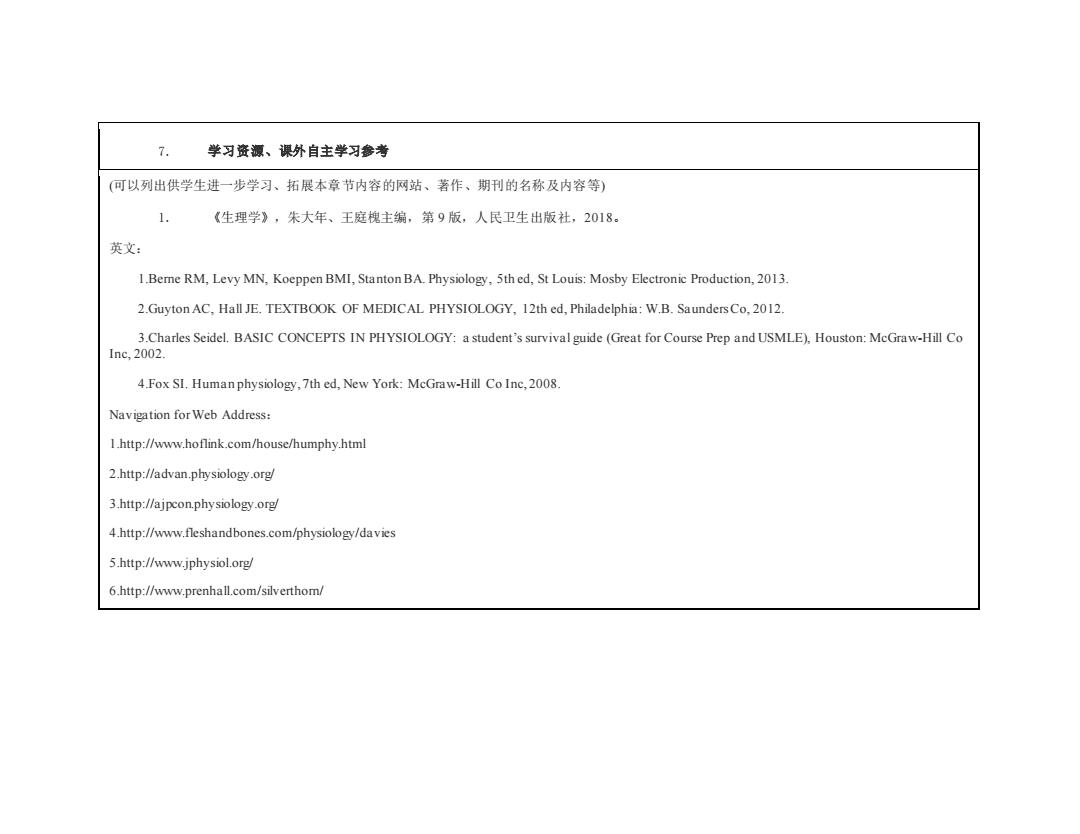
7. 学习资源、课外自主学习参考 (可以列出供学生进一步学习、拓展本章节内容的网站、著作、期刊的名称及内容等) 1. 《生理学》,朱大年、王庭槐主编,第9版,人民卫生出版社,2018。 英文: 1.Beme RM,Levy MN,Koeppen BMI,Stanton BA.Physiology,5th ed,St Louis:Mosby Electronic Production,2013. 2.Guyton AC,Hall JE.TEXTBOOK OF MEDICAL PHYSIOLOGY,12th ed,Philadelphia:W.B.Saunders Co,2012. 3.Charles Seidel.BASIC CONCEPTS IN PHYSIOLOGY:a student's survival guide(Great for Course Prep and USMLE),Houston:McGraw-Hill Co 1nc,2002. 4.Fox SI.Human physiology,7th ed,New York:McGraw-Hill Co Inc,2008. Navigation for Web Address: 1.http://www.hoflink.com/house/humphy.html 2.http://advan.physiology.org/ 3.http://ajpcon.physiology.org/ 4.http://www.fleshandbones.com/physiology/davies 5.http://www.jphysiol.org/ 6.http://www.prenhall.com/silverthom/
7. 学习资源、课外自主学习参考 (可以列出供学生进一步学习、拓展本章节内容的网站、著作、期刊的名称及内容等) 1. 《生理学》,朱大年、王庭槐主编,第 9 版,人民卫生出版社,2018。 英文: 1.Berne RM, Levy MN, Koeppen BMI, Stanton BA. Physiology, 5th ed, St Louis: Mosby Electronic Production, 2013. 2.Guyton AC, Hall JE. TEXTBOOK OF MEDICAL PHYSIOLOGY, 12th ed, Philadelphia: W.B. Saunders Co, 2012. 3.Charles Seidel. BASIC CONCEPTS IN PHYSIOLOGY: a student’s survival guide (Great for Course Prep and USMLE), Houston: McGraw-Hill Co Inc, 2002. 4.Fox SI. Human physiology, 7th ed, New York: McGraw-Hill Co Inc, 2008. Navigation for Web Address: 1.http://www.hoflink.com/house/humphy.html 2.http://advan.physiology.org/ 3.http://ajpcon.physiology.org/ 4.http://www.fleshandbones.com/physiology/davies 5.http://www.jphysiol.org/ 6.http://www.prenhall.com/silverthorn/

苏州大学医学部药学院授课教案
苏州大学医学部药学院授课教案
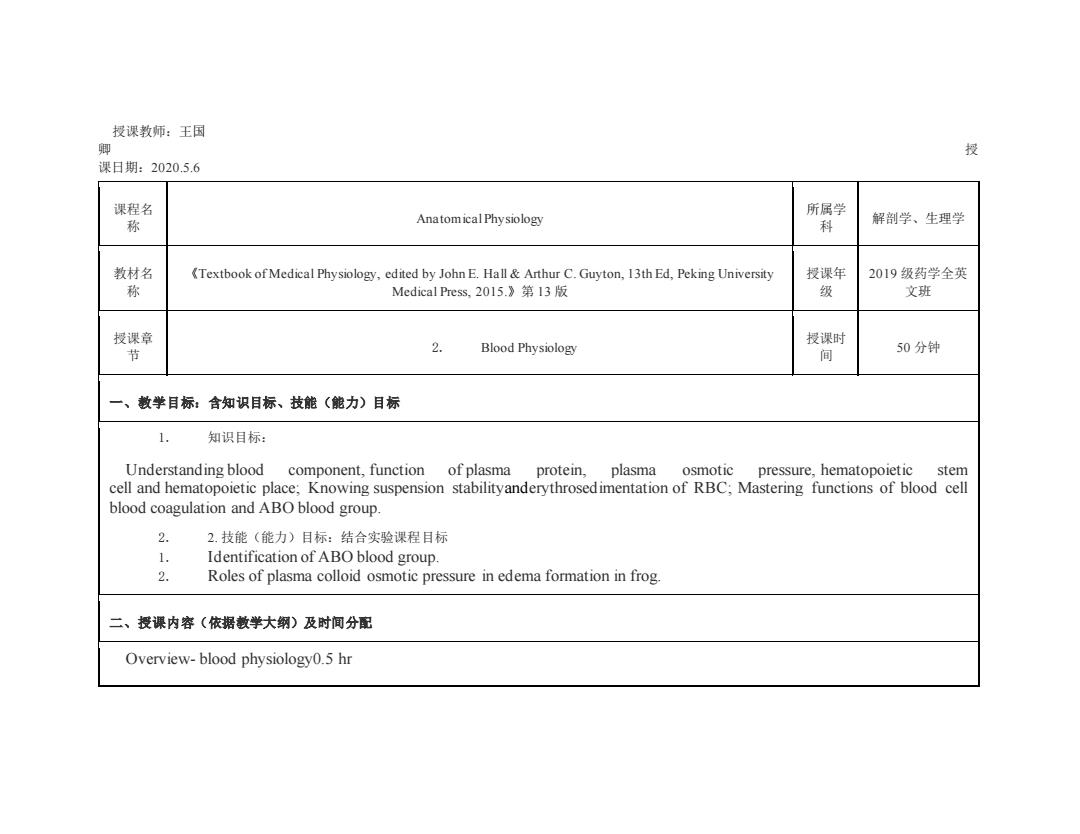
授课教师:王国 卿 授 课日期:2020.5.6 课程名 Anatomical Physiology 所属学 称 科 解剖学、生理学 教材名 (Textbook of Medical Physiology,edited by John E.Hall Arthur C.Guyton,13th Ed,Peking University 授课年 2019级药学全英 称 Medical Press.2015.》第13版 级 文班 课章 授课时 节 2. Blood Physiology 间 50分钟 一、教学目标:含知识目标、技能(能力)目标 1. 知识目标: Understanding blood component,function of plasma protein, plasma osmotic pressure,hematopoietic stem cell and hematopoietic place:Knowing suspension stabilityanderythrosedimentation of RBC:Mastering functions of blood cell blood coagulation and ABO blood group. 2. 2.技能(能力)目标:结合实验课程目标 1. Identification of ABO blood group. 2. Roles of plasma colloid osmotic pressure in edema formation in frog. 二、授课内容(依据教学大纲)及时间分配 Overview-blood physiology0.5 hr
授课教师:王国 卿 授 课日期:2020.5.6 课程名 称 Anatomical Physiology 所属学 科 解剖学、生理学 教材名 称 《Textbook of Medical Physiology, edited by John E. Hall & Arthur C. Guyton, 13th Ed, Peking University Medical Press, 2015.》第 13 版 授课年 级 2019 级药学全英 文班 授课章 节 2. Blood Physiology 授课时 间 50 分钟 一、教学目标:含知识目标、技能(能力)目标 1. 知识目标: Understanding blood component, function of plasma protein, plasma osmotic pressure, hematopoietic stem cell and hematopoietic place; Knowing suspension stabilityanderythrosedimentation of RBC; Mastering functions of blood cell blood coagulation and ABO blood group. 2. 2. 技能(能力)目标:结合实验课程目标 1. Identification of ABO blood group. 2. Roles of plasma colloid osmotic pressure in edema formation in frog. 二、授课内容(依据教学大纲)及时间分配 Overview- blood physiology0.5 hr

Blood coagulation and physiological hemostasis0.25 hr Blood volume,blood transfusion and blood group0.25 hr 三、教学里点与难点 1. 教学重点 Plasma osmotic pressure(POP)and its function for water migration in the body.Function of plasma protein;Hematopoietic stem cell and hematopoietic place;Suspension stabilityanderythrosed imentation of RBC; Physiological function and erythropoietic regulationof red blood cell:Physiological function of various leukocytes,phagocyte and nonspecific immunity,lymphocyte and immunity;Physiological characteristic and function of thrombocytes; Blood coagulation Blood volume:blood transfusion and blood group of erythrocyte(ABOblood group system and Rhblood group system),leucocyte group and platelet group. 2. 教学难点 Blood coagulation Blood group(ABOblood group system and Rhblood group system) 四、教学方法选择
Blood coagulation and physiological hemostasis0.25 hr Blood volume, blood transfusion and blood group0.25 hr 三、教学重点与难点 1. 教学重点 Plasma osmotic pressure (POP) and its function for water migration in the body. Function of plasma protein; Hematopoietic stem cell and hematopoietic place; Suspension stabilityanderythrosedimentation of RBC; Physiological function and erythropoietic regulationof red blood cell; Physiological function of various leukocytes, phagocyte and nonspecific immunity, lymphocyte and immunity; Physiological characteristic and function of thrombocytes; Blood coagulation ;Blood volume;blood transfusion and blood group of erythrocyte (ABOblood group system and Rhblood group system), leucocyte group and platelet group. 2. 教学难点 Blood coagulation ;Blood group (ABOblood group system and Rhblood group system) 四、教学方法选择

理论课堂教学 A多媒体教学:(简要列出本章节多媒体教学设计特点及优势) 采用示意图、图片、表格等介绍,由表及里,情景带入,紧扣生活体验和临床实践。 B.互动教学:(根据实际情况列出案例/实例讨论、分析讨论、分组讨论、翻转课堂等互动教学内容标题) 课堂提问与读书报告会相结合 五、更新或补充内容提要 本章知识点国内外新进展一造血干细胞生物学特性及其应用 六、复习思考题 1.What is the function of Blood 2.What is the componentsand function ofblood plasma osmotic pressure 3.Please answer hemopoietic stem cells's basic characteristics. 4.What is the basic steps of blood coagulation. 5.Please answer principle of blood transfusion. 七、学习资源、课外自主学习参考
理论课堂教学 A. 多媒体教学:(简要列出本章节多媒体教学设计特点及优势) 采用示意图、图片、表格等介绍,由表及里,情景带入,紧扣生活体验和临床实践。 B. 互动教学:(根据实际情况列出案例/实例讨论、分析讨论、分组讨论、翻转课堂等互动教学内容标题) 课堂提问与读书报告会相结合 五、更新或补充内容提要 本章知识点国内外新进展—造血干细胞生物学特性及其应用 六、复习思考题 1. What is the function of Blood ? 2. What is the components and function of blood plasma osmotic pressure ? 3. Please answer hemopoietic stem cells`s basic characteristics. 4. What is the basic steps of blood coagulation . 5. Please answer principle of blood transfusion. 七、学习资源、课外自主学习参考